While the average ancient technology may not be able to compete with our modern gadgets and gizmos like Netflix and artificial intelligence, they are still worth exploring for their sheer ingenuity and quirkiness.
From the mysterious Antikythera Mechanism to the massive pyramids of Giza, these technologies showcase the creativity and resourcefulness of our ancestors.
Table of Contents
The Antikythera Mechanism: Timepiece of the Galaxy
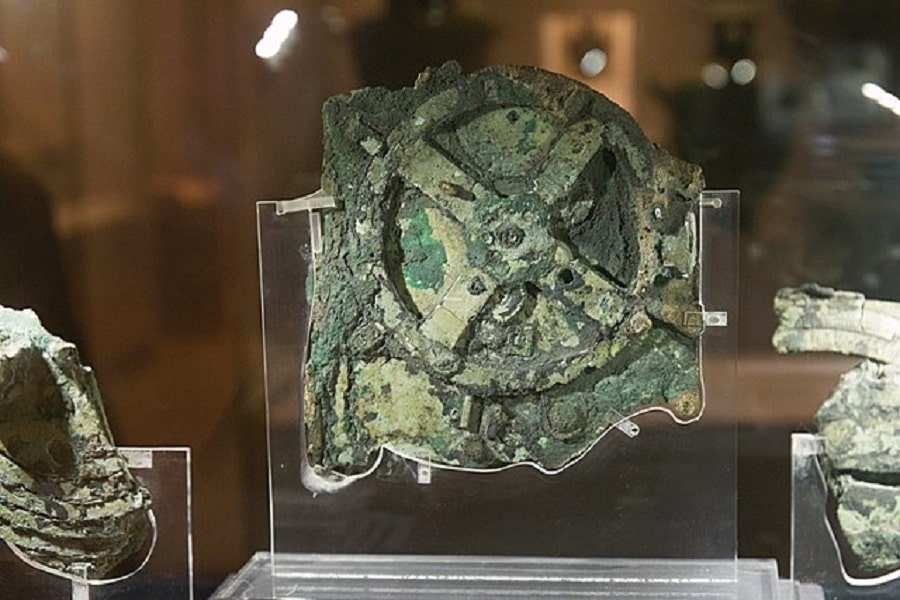
This is one of the staples you will come across when researching exciting technologies in the ancient world.
The Antikythera Mechanism was built around the year 100 BCE (which is way before even the first iPhone). It’s still a mystery how the ancient Greeks packed so much advanced technology into such a small package.
This little device comprises over 30 bronze gears, dials, and pointers, housed in a wooden case about the size of a shoebox. It’s like a tiny mechanical computer designed to predict eclipses and track the movements of celestial bodies such as the moon and the sun. We are talking about monitoring planetary motions, solar eclipses, and possibly sniping spaceships.
The Antikythera mechanism (in its prime) must’ve been an actual work of art, with intricate engravings and decorations covering its surface. It’s like a bronze and wood version of the Apple Watch, but instead of telling you the time, it tells you when the next eclipse will happen (which is probably a lot more practical if you think about it).
The mechanism was discovered under the sea in 1900 when divers found a shipwreck off the coast of Antikythera. It took decades of painstaking research to understand what it was and how it worked.
Today, it is displayed in the National Archaeological Museum in Athens and is popular among tech and history enthusiasts.
The Iron Pillar of Delhi: A Symbol of Endurance

The Iron Pillar of Delhi is a towering testament to ancient Indian technology.
Located in Delhi’s Qutub complex, this massive monument is made of a high-grade iron alloy. It dates back to the Gupta Empire (4th-6th century CE). Standing at over 23 feet and weighing 6 tons, the Iron Pillar is adorned with intricate carvings and inscriptions.
Here’s what’s going to blow your mind:
Having survived for over 1600 years without a hint of rust or corrosion, the Pillar is considered a marvel of ancient metallurgy. This clearly shows the technological innovation of the ancient Indians and how much they were ahead of their time.
The Pillar was discovered in the 19th century and is believed to have originally been erected near the Udayagiri Caves and later transported to its current location.
These days, it’s a popular tourist spot and a symbol of India’s rich history and culture.
The Phaistos Disc: A Circular Enigma

The Phaistos Disc is like an ancient clay version of a Rubik’s Cube, except instead of matching up the colors, you’re trying to figure out what all those weird symbols on its body mean. This little disc has been driving historians and archaeologists crazy for years, with no one able to figure out what it’s all about.
It was found on the island of Crete in the early 20th century and is thought to be really old (like the second millennium BCE old). It’s covered in fancy designs and has a bunch of spirals that really lead to nowhere.
Many scholars believe this contraption was a practical joke, given how the signs are literally incomprehensible.
No one knows for sure, but one thing is certain: our ancient ancestors were innovative regarding technology and communication.
READ MORE: King Minos of Crete: The Father of The Minotaur
The Archimedes Screw: A Timeless Innovation
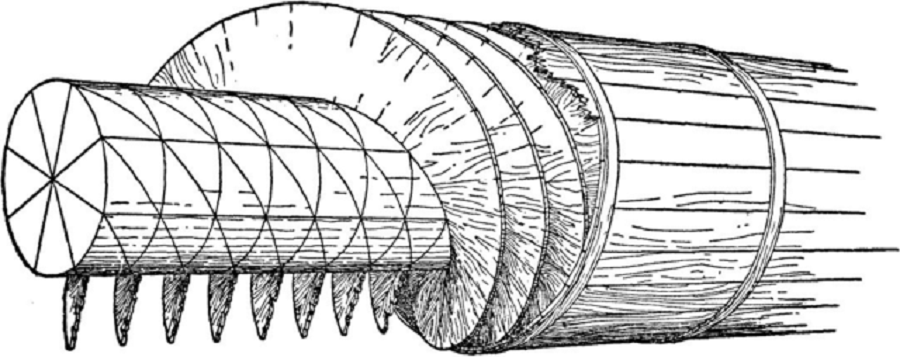
The Archimedes screw, a device created by the famous ancient Greek mathematician and engineer Archimedes, is a simple machine consisting of a long helical screw placed inside a tube or pipe.
READ MORE: Who Invented Math? The History of Mathematics
Even though Archimedes is credited with popularizing the mechanism, the technology was most probably also used by Egyptians long before his Eureka moment.
When the screw is turned, it lifts the material inside the tube upward. The Archimedes screw is an effective and efficient way to move water or other materials from a lower to a higher elevation.
READ MORE: Who Invented Water? History of the Water Molecule
And guess what?
It is still commonly used in irrigation systems, water treatment plants, and sewage treatment facilities due to its simplicity and attractive design. This makes it one of the most timeless and effective pieces of ancient technology still being used today.
The Greek Fire: The Unstoppable Force

Don’t think the ancient Greeks only confined themselves to writing insane Greek mythology.
They were well-practiced in engineering sciences and the pioneers of several engineering sciences. So it’s only natural that their technological trickeries advanced to other parts of the world.
Greek fire was like the ancient version of a flamethrower, except it could burn on water instead of just lighting people on fire.
That’s right, this mysterious substance was so intense that it could light up the ocean. The Byzantines used it during naval battles to fry their enemies, and it was so top-secret that no one knew exactly what it was made of.
Some say it was a mixture of sulfur, pitch, and naphtha, while others think it was just a bunch of really flammable chemicals mixed together. Whatever it was, Greek fire was no joke, and it could be launched from a fancy syringe called a siphon. It was also rumored to be super sticky, so once it was on you, you were pretty much toast.
The origins of the Greek fire are shrouded in mystery, but it is believed to have been invented by the Byzantines in the 7th century CE. Some historians speculate that it was developed by the Byzantine inventor and engineer Callinicus of Heliopolis, who is credited with creating several other military technologies and devices.
Regardless of who invented it, Greek fire was a formidable weapon used significantly by the Byzantines in their wars against the Arab and Ottoman empires.
The Concrete of the Roman Empire: The Immovable Object

Have you ever wondered how the ancient Romans built structures that have lasted for thousands of years?
Well, wonder no more because the secret is out: Roman concrete!
This revolutionary building material changed the game for the Romans, who used it to construct everything from aqueducts to roads to buildings.
And let us tell you, the concrete of the Roman empire was no joke.
It was so strong and durable that many of those structures still stand today. But what made Roman concrete so special? Well, it was all thanks to its unique formula, which included a mixture of volcanic ash, lime, and water. As this mixture hardened over time, it became a rock-solid material that could withstand all kinds of weathering and erosion.
No wonder the Romans used it extensively in their construction projects – it was a crucial part of their empire-building efforts.
The Ramp System of Ancient Egypt: Efficiency At Its Peak
Ever wonder how the ancient Egyptians built their graceful pyramids? What was the technology in ancient Egypt like?
Spoiler alert: unfortunately, it wasn’t aliens.
Have you ever tried to move a giant stone block across rough terrain? It’s not exactly easy, is it? But the ancient Egyptians figured out a way to do it – with ramps!
These ramps were used to transport heavy objects, like stone blocks, from one place to another, and we are talking hundreds of miles at times. The system was implemented using a series of interlocking blocks that were stacked on top of each other, creating a sloping pathway that could be used to haul those big objects up or down.
The design of the ramps varied depending on the project. Still, they all used the same basic principles of leverage and weight distribution. So next time you’re trying to move a giant stone block, just think: if the Egyptians could do it with a ramp, so can you!
Don’t try it at home, though.
The Baghdad Battery: A True Shocker
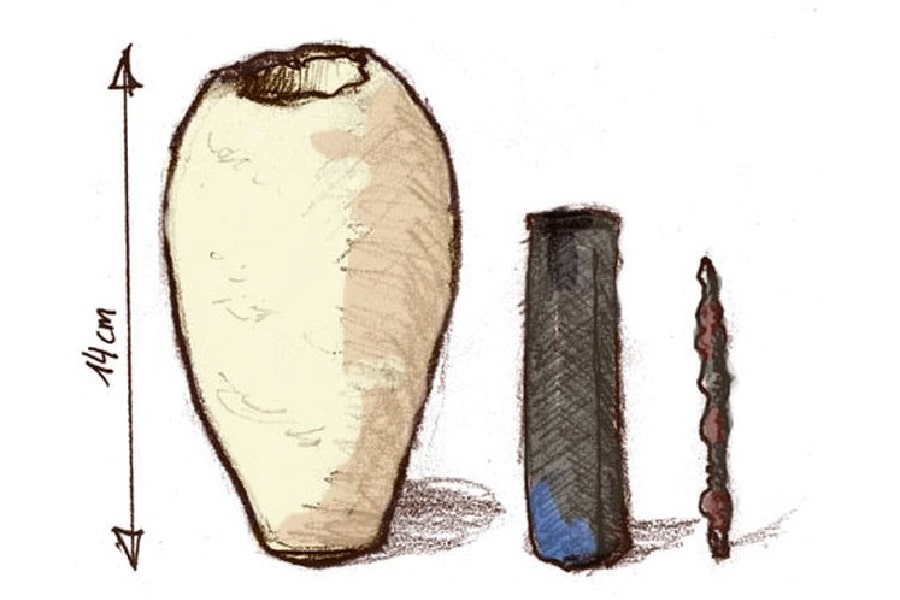
The Baghdad Battery is an ancient artifact from the Middle East that has had historians and archaeologists scratching their heads for centuries about how our ancestors discovered electricity so early on.
This little clay jar is thought to be super old (like 2nd-3rd century CE old) and is believed to have been used as a primitive electrical Battery.
The jar is about the size of a small water bottle and is decorated with fancy designs and inscriptions. But the real magic is inside the jar, where you’ll find a copper cylinder and an iron rod separated by a layer of asphalt.
What’s even more remarkable, the Battery could’ve probably produced an electrical current when the jar was filled with a specific type of electrolyte solution.
Benjamin Franklin would’ve been proud.
The Astrolabe: A Starry Calculator
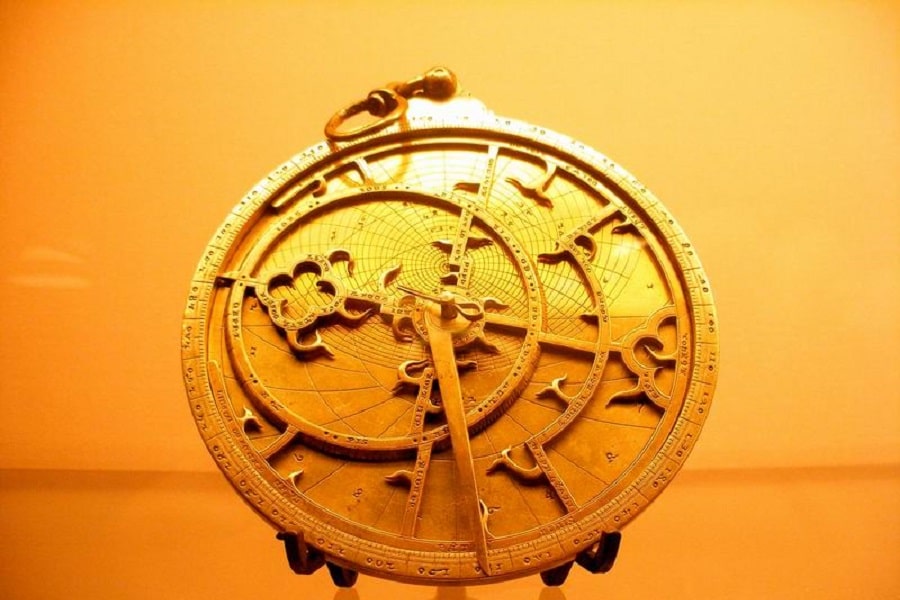
Have you ever wanted to measure the positions of the stars and other celestial bodies?
Some ancient people did, and they invented the astrolabe to do it!
This unique device has a long and storied history, and it’s been used by all sorts of people, like astronomers, navigators, and mathematicians.
The astrolabe, too, has its roots in ancient Greeks’ brains, which were developed by a bunch of smarty-pants astronomers, mathematicians, and philosophers. It is often dubbed a “handheld model of the universe.”
It’s a complex and intricate device that consists of a circular disk called a mater, which is mounted on a handle or rod. The device is inscribed with scales and arcs used to measure celestial objects’ altitude above the horizon.
And astrolabes were used for all sorts of things, like telling time (before smartwatches), predicting solar eclipses (so you know when to hide from the sky), and finding your way at sea (before GPS). The astrolabe is a testament to our ancient ancestors’ advanced technologies and scientific knowledge, and it’s a lasting reminder of the innate human desire to understand the universe and our place in it.
Or maybe they just really liked stargazing. Who knows? Not all of us love the idea of suffering from an existential crisis.
The Seismoscope of Ancient China: For When Things Get Shaky
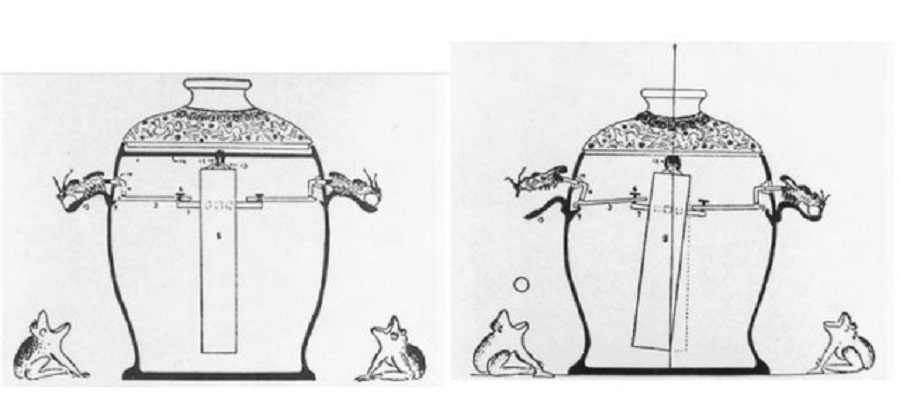
There’s a new earthquake detector in town!
Meet the ancient Chinese seismoscope, the world’s first recorded device for detecting earthquakes. But who was the genius behind this mechanism?
No other than the brilliant Chinese scientist and statesman Zhang Heng was truly the Einstein of his time.
Picture a giant drum with a bunch of bronze dragon heads sticking out of it, each with a ball in its mouth. No, seriously. That’s what it looked like. Talk about fierce earthquake detection!
Whenever there was an earthquake, the balls would then fall from the dragon’s head into the mouth of a copper toad below. This would then produce a sound, alerting Mr. Heng’s neighbors to drop, cover, and hold on.
The simplicity of this ancient seismoscope is perhaps its most remarkable beauty.
The Hieroglyphs of Ancient Egypt; Transcending Language
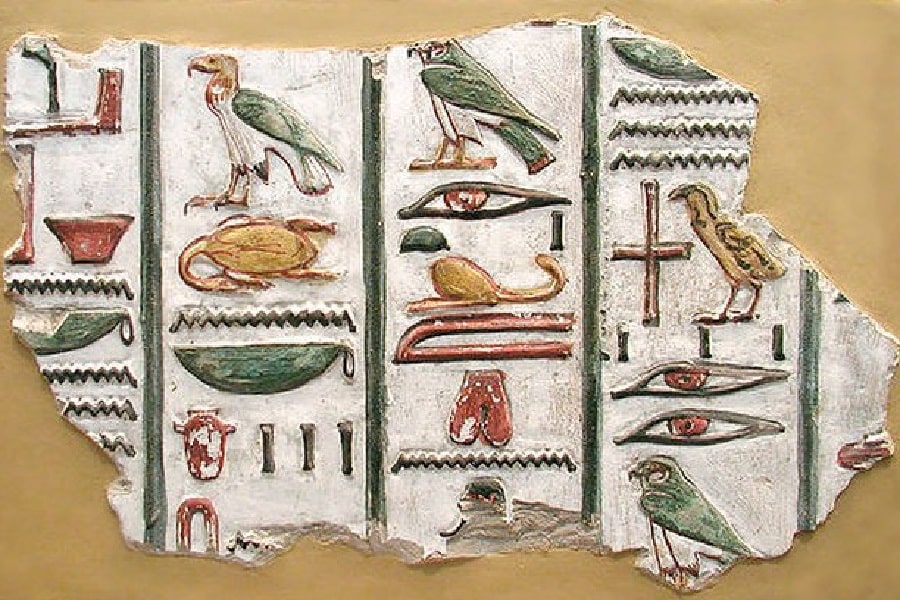
The wonders of ancient Egypt just don’t seem to stop coming.
From pyramids to pharaohs, there’s much to discover about this fascinating civilization. But did you know that the Egyptians had their own system of writing? It’s called hieroglyphs, and these mysterious symbols were used to record their thoughts and, not to mention their rich mythology.
READ MORE: 35 Ancient Egyptian Gods and Goddesses
But where did hieroglyphics come from? It’s a bit of a mystery, but they were developed over time by the Egyptians themselves.
Hieroglyphs were often carved into stone or written on papyrus and used to document everything from everyday life to religious texts.
So, how did hieroglyphs actually function? Each symbol represented a different word or concept, like an alphabet. So if you wanted to write the word “cat,” you might use a symbol that looked like a cat. And if you wanted to write the word “pharaoh,” you might use a character that looked like a king’s crown. They were often exquisitely drawn, with lots of intricate details and symbols.
Pretty cool, right?
So the next time you’re at a museum, and you see some strange symbols on an ancient Egyptian artifact, don’t just brush them off as nonsense – they were a sophisticated and advanced system of writing that was used by the Egyptians thousands of years ago!
Damascus Steel: The Devil in the Details

Damascus, the city of jasmine and sword blades, is located in the beautiful country of Syria. It has a long and storied history, with some historians claiming that it’s the oldest continuously inhabited city in the world!
But enough about its age, let’s talk about its more deadly aspect: its famous Damascus steel.
This metal was used to create some of the sharpest and strongest swords in the land. But how did they make it? That’s a closely guarded secret lost to the ages (or did the entire stock just get demolished in the forge?).
All we know is that it involved pounding and folding the steel repeatedly, giving it a unique and beautifully detailed pattern.
Speaking of appearance, it’s easy to distinguish a Damascus steel sword from a normal one. Just imagine a shimmering sword with swirling patterns on the blade.
It’s enough to make any medieval blacksmith green with envy. It’s no surprise that these swords were highly coveted and used by all sorts of fierce warriors across the ancient world. After all, it was highly durable, sharp, and, most importantly, super snazzy.
Damascus steel blades can be restored, but it’s a complex and time-consuming process. Unfortunately, the method of making Damascus steel has been lost to history, so it’s hard to know the best way to care for and restore these blades.
The Ancient Roman Aqueducts: Quenchers of Thirst
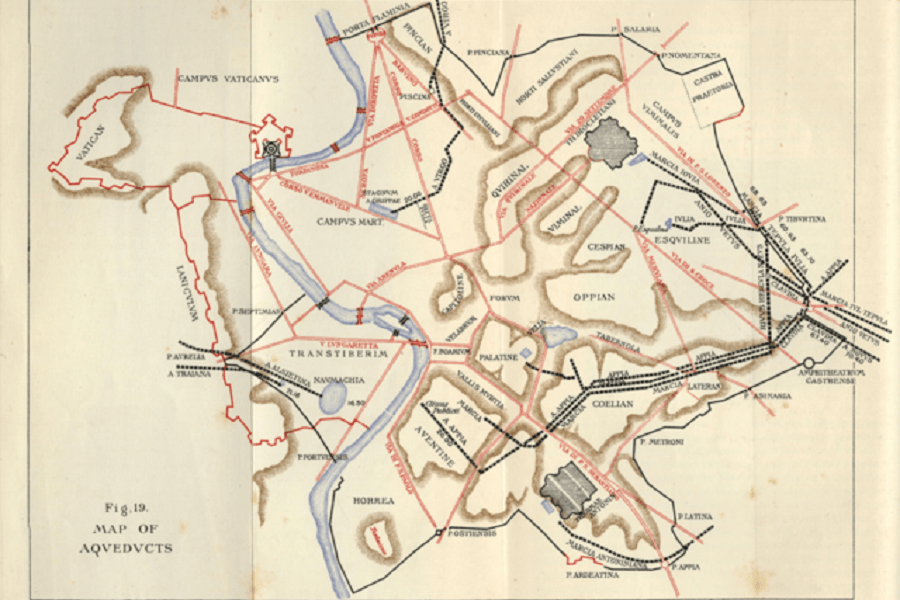
While many ancient civilizations on the other side of the world were suffering from the shortage of clean water, Rome was simply vibing.
The ancient Romans knew how to party, and their aqueducts were the life of the party!
These impressive engineering feats brought much-needed H2O from distant places to the cities for drinking, bathing, and getting rid of all that stink. These aqueducts were the ultimate thirst-quenchers, built of sturdy stone or brick and supported by arches or bridges.
And the Romans were total pros at construction – they used all sorts of tricks, like inverted siphons, to ensure the water flowed smoothly. The first aqueduct, the Aqua Appia, was built way back in 312 BC by Appius Claudius Caesus.
But it was during the height of the Roman Empire (1st to 3rd centuries AD) that really impressive aqueducts were built, like the Pont du Gard in France and the Aqua Augusta in Italy.
These sophisticated water delivery systems not only satisfied the needs of the growing population but also flexed the empire’s wealth and power on their rivals.
The Roman Dodecahedron: A Puzzling Paradox
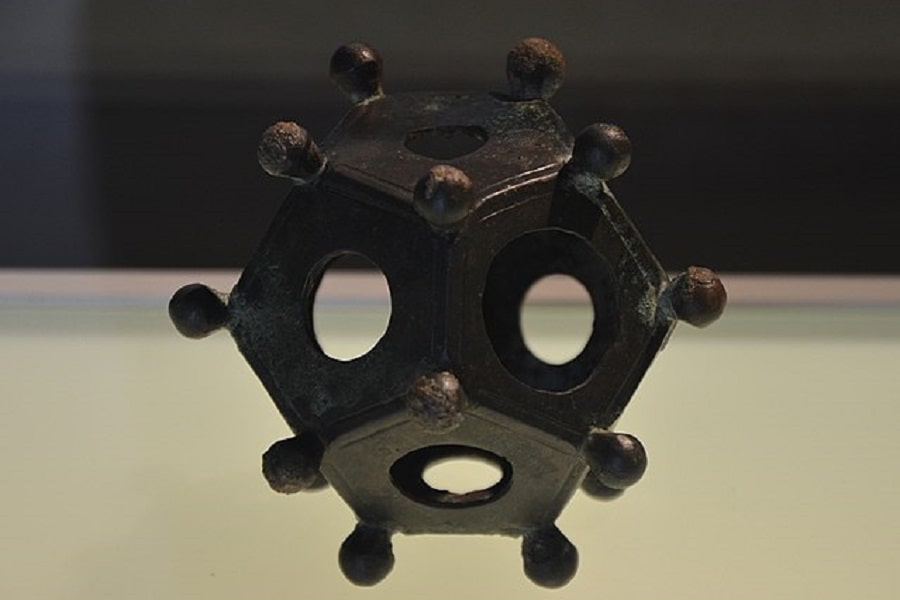
The Roman dodecahedron is a bizarre and perplexing relic.
It’s a tiny bronze object with 12 flat faces, each with a little hole in the middle. Some say it was invented by the Romans as a fancy toy or a divination device, and others think it might have been used in some secret rituals.
It has yet to be determined for sure what the dodecahedron was for. Still, it’s a weird and exciting artifact that could’ve been an experimental part of extremely advanced inventions.
The first one was dug up in a field in Italy back in the 19th century, and since then, lots more have been found all over Europe. Despite its fame, we still don’t know much about the history of the Roman dodecahedron or who made it.
The Shigir Idol: A Standing Beauty

The Shigir Idol is a true treasure of the ancient history of art.
Standing tall at over 17 feet, this ancient wooden sculpture was discovered in a peat bog in the Ural Mountains of Russia in 1890. The Shigir Idol has been perfectly preserved thanks to the unique conditions in which it was found. It is believed to be around 9,500 years old – making it one of the oldest wooden sculptures.
It’s intricately carved with beautiful abstract patterns and symbols, each possibly hinting at a story about the creation myth of their culture (“their” being whoever the craftsman was).
Now housed in a museum in Yekaterinburg, Russia, the Shigir Idol is a must-see for anyone interested in ancient art and history.
Relative to ancient times, it truly is a masterpiece!
Ancient Technology vs. Modern Technology
Okay fine, ancient technologies are less useful now. Long gone are the days of stone tools and the gearwheels of an ancient computer.
But let’s look at the meat of it.
These technologies were often extremely advanced for their time and allowed significant progress and advancement within those societies. Many ancient civilizations developed interesting technologies that were way ahead of their time.
In contrast, modern technology is often more complex and advanced than in the past. However, understand that the machines we have today wouldn’t have been possible without innovation from thousands of years ago.
After all, where would we even be without wheels or, more importantly, writing?
The human species has made significant progress and advancement through the development of both ancient and modern technology. It will be interesting to see what technologies the future holds for us.
Conclusion
So, did these old technologies and ancient inventions fascinate you?
If so, make sure to appreciate whatever modern inventions you have in front of you; they won’t be modern forever!
References
“The Antikythera Mechanism: A Complex Ancient Greek Astronomical Computer” by Alexander Jones (Journal of the American Philosophical Society, Vol. 148, No. 2, June 2004)
https://www.jstor.org/stable/10.2307/4136088
“Mapping the Heavens: The Radical Scientific Ideas That Reveal the Cosmos” by Nicholas J. Wade (Princeton University Press, 1996)
https://www.jstor.org/stable/j.ctt9qgx3g
“The Engineering of the Pyramids” by Mark Lehner (Scientific American, Vol. 270, No. 6, June 1994)
https://www.jstor.org/stable/24938067
“Hydraulic Civilization in Ancient China: A Review” by Hsiao-chun Hung (Technology and Culture, Vol. 50, No. 4, October 2009)